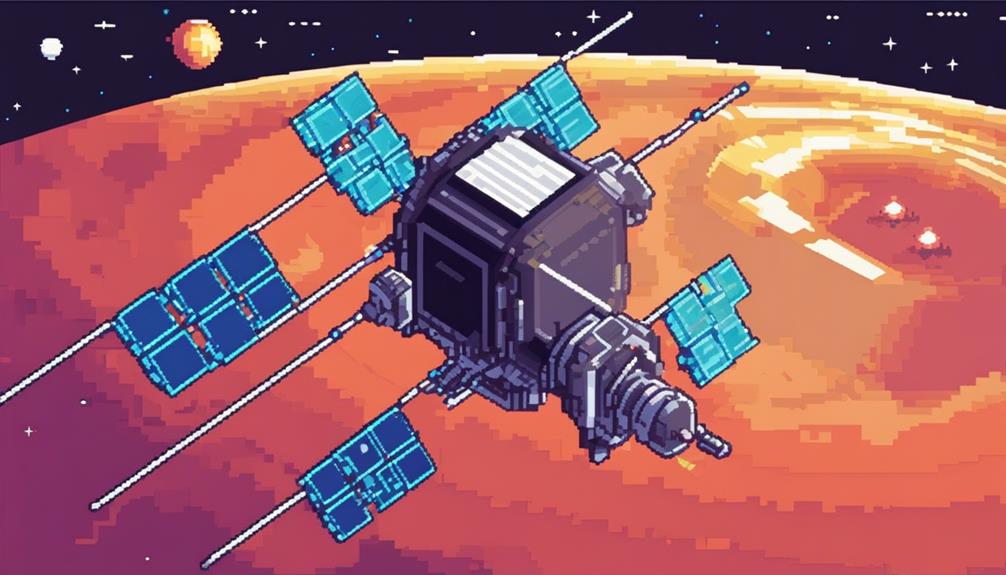The realm of satellite communication technology is experiencing a profound transformation through various innovative advancements. From the utilization of laser communications for enhanced bandwidth to the integration of artificial intelligence for improved network management, the landscape is evolving at a rapid pace. Additionally, technologies like optical inter-satellite links and secure quantum communications are reshaping the way we perceive satellite connectivity. These developments hold the promise of revolutionizing not just how we communicate globally but also how we interact with the vast expanse of space.
Key Takeaways
- Laser Communications offer high-speed data transmission with superior bandwidth and security.
- Software-Defined Satellites bring flexibility and adaptability to optimize satellite functions.
- Secure Quantum Communications ensure unparalleled data confidentiality and protection against cyber threats.
- Satellite Swarm Technology enhances coverage and flexibility for synchronized data collection tasks.
Laser Communications

Laser communications in satellite technology represent a cutting-edge advancement utilizing focused laser beams for high-speed data transmission between satellites and ground stations. This technology offers superior bandwidth capacity and enhanced security features compared to traditional radio frequency links. In satellite networks, laser communications play a crucial role in enabling high-speed data transmission, supporting inter-satellite communication, and reducing the dependence on ground stations for relaying information.
The implementation of laser communications in satellite systems has revolutionized data transmission capabilities, providing significantly higher data rates and more secure transmissions. By leveraging optical links for inter-satellite communication, satellite networks can achieve improved performance and resilience, leading to enhanced connectivity and network efficiency.
Despite the numerous benefits, challenges exist in the adoption of laser communications in satellites. These challenges include the need for precise alignment accuracy, sensitivity to weather conditions, and the cost implications associated with integrating optical communication systems into satellite platforms. Addressing these challenges is crucial for maximizing the potential of laser communications in satellite technology and ensuring the seamless operation of advanced satellite networks.
High-Throughput Systems
Utilizing advanced technologies to enhance data rates and capacity, high-throughput satellite systems revolutionize broadband communication by employing spot beams, frequency reuse, and onboard processing for optimized data transmission efficiency. These systems operate mainly in Ka-band frequencies to deliver high-speed internet services and connectivity over vast geographical areas. Here are some key points highlighting the significance of high-throughput systems:
- Enhanced Data Rates: High-throughput systems offer significantly increased data rates compared to traditional satellite communication methods, enabling faster and more reliable internet connections.
- Improved Coverage: By utilizing spot beams, these systems can focus their signals on specific areas, providing more targeted and efficient coverage while reducing interference and improving overall performance.
- Cost-Effective Connectivity: Through frequency reuse techniques, high-throughput satellites can maximize the utilization of available spectrum resources, offering cost-effective broadband solutions for both urban and remote regions.
- Diverse Applications: High-throughput systems support a wide range of applications such as video streaming, telecommunication services, and remote sensing, catering to the diverse needs of consumers and businesses alike.
Optical Inter-Satellite Links

An integral component of modern satellite communication systems, optical inter-satellite links facilitate high-bandwidth data transmission between satellites, significantly enhancing network performance and reliability. Optical inter-satellite links utilize laser beams for data transmission, offering a higher bandwidth capacity compared to traditional radio frequency links. This technology enables direct communication between satellites, reducing reliance on ground stations and enhancing network resilience.
Despite its advantages, optical inter-satellite links face challenges such as the need for precise alignment between satellites, sensitivity to weather conditions, and cost implications associated with implementing the technology. However, the benefits of reduced latency in data transmission and the potential for satellite network optimization make optical links a crucial innovation in satellite communication systems.
Advancements in optical inter-satellite links are driving the evolution of satellite communication technology by providing enhanced connectivity and reducing dependency on conventional communication methods. By improving data transmission speeds and network efficiency, optical inter-satellite links play a vital role in optimizing satellite communication systems for future applications. The continuous development in this field underscores the significance of optical inter-satellite links in advancing the capabilities of satellite networks.
Software-Defined Satellites
Enhancing satellite communication systems with advanced flexibility and real-time adaptability, software-defined satellites leverage reconfigurable software to control and optimize satellite functions. This innovative technology allows for dynamic allocation of resources and capabilities based on mission requirements, leading to enhanced flexibility, efficiency, and security in satellite communication systems. Software-defined satellites enable rapid updates and customization without the need for physical hardware changes, offering a cost-effective and agile solution for satellite operations in the evolving space industry.
- Revolutionizing Satellite Operations: Software-defined satellites pave the way for more agile and adaptable satellite operations, revolutionizing the way we communicate globally.
- Enhanced Flexibility: The reconfigurable nature of software-defined satellites provides unparalleled flexibility in managing satellite functions to meet the dynamic demands of modern communication needs.
- Real-time Adaptability: With the ability to adapt in real-time, software-defined satellites ensure optimal performance and responsiveness to changing communication requirements.
- Future-proof Communication: By embracing software-defined satellite technology, the communication industry is future-proofing its infrastructure, ready to meet the challenges of tomorrow's interconnected world.
Artificial Intelligence Integration

Satellite communication systems have evolved significantly with the integration of artificial intelligence, marking a crucial advancement towards autonomous operations and heightened efficiency. The incorporation of AI algorithms in satellite systems plays a pivotal role in enhancing data processing capabilities, enabling complex functions, and facilitating faster decision-making processes. By leveraging AI technology, satellite systems can achieve improved overall performance, adaptability, and responsiveness to dynamic and evolving conditions in space.
One of the key benefits of AI integration in satellite communication is the support for advanced functions such as autonomous navigation, resource optimization, and predictive maintenance. Autonomous navigation capabilities enable satellites to make real-time course corrections and adjustments without human intervention, enhancing operational efficiency. Additionally, AI-driven predictive maintenance algorithms allow for proactive identification of potential issues, enabling timely maintenance actions to prevent failures and downtime.
Moreover, the utilization of artificial intelligence in satellite communication drives innovation by enabling the development of smarter and more efficient satellite networks. These intelligent networks can dynamically allocate resources, optimize data transmission, and adapt to changing demand patterns, ultimately enhancing the overall performance and reliability of satellite communication systems. The integration of AI in satellite communication technology represents a significant leap forward in transforming the capabilities and efficiency of satellite operations.
Secure Quantum Communications
Secure quantum communications represent a paradigm shift in data security, primarily through Quantum Key Distribution (QKD) mechanisms that leverage quantum phenomena for generating encryption keys. Entanglement-based communication ensures the confidentiality of information by detecting any unauthorized interception attempts using quantum entanglement and superposition principles. Additionally, quantum-resistant encryption methods provide robust protection against cyber threats, offering unparalleled security for sensitive data exchanges.
Quantum Key Distribution
Utilizing the principles of quantum mechanics, Quantum Key Distribution (QKD) revolutionizes secure communication by establishing encryption keys in a quantum-safe manner. QKD ensures secure transmission by detecting any unauthorized interception attempts through the principles of quantum mechanics. The security of QKD is based on the fundamental properties of quantum mechanics, making it highly resistant to hacking or eavesdropping. Quantum communication protocols like QKD provide a new level of security for sensitive data transmission, especially in critical industries like finance, defense, and healthcare. QKD offers a future-proof solution for secure communication networks, safeguarding against potential threats posed by quantum computing advancements.
- Unhackable security
- Cutting-edge data protection
- Quantum-proof encryption
- Industry-grade secure communication
Entanglement-Based Communication
Exploring the intricacies of quantum entanglement, researchers are delving into the transformative potential of entanglement-based communication for enhancing the security and reliability of data transmissions in satellite communication systems. Entanglement-based communication leverages the unique properties of quantum entanglement, where the state of one particle is correlated with another regardless of distance. This technology enables ultra-secure data transmission as any interception would disrupt the entanglement, alerting the parties involved. By implementing entanglement-based communication, satellite systems can significantly improve the privacy and reliability of their data transmissions. The table below summarizes the key features of entanglement-based communication in satellite systems.
| Features | Description |
|---|---|
| Secure Communication | Utilizes quantum entanglement for secure and instantaneous data transfer |
| Data Transmission | Enhances the security and reliability of data transmissions in satellites |
| Quantum Entanglement | Ensures direct correlation between particle states for secure communication |
| Eavesdropping Detection | Any interception attempts disrupt entanglement, immediately detectable |
| Privacy Enhancement | Revolutionizes data security and encryption methods in satellite systems |
Quantum-Resistant Encryption
Quantum-resistant encryption plays a critical role in fortifying the security of data transmitted through satellite communication systems by mitigating potential threats posed by quantum computing advancements. This encryption method utilizes mathematical principles that withstand quantum attacks, ensuring secure communication channels. Implementing quantum-resistant encryption in satellite communication systems enhances data security and confidentiality, safeguarding sensitive information transmitted via satellites from potential quantum decryption. The development of quantum-resistant encryption is pivotal for future-proofing satellite communications against emerging quantum computing capabilities.
- Enhances data security
- Safeguards against quantum decryption
- Mitigates potential threats
- Ensures secure communication channels
Interplanetary Communication Advancements
Interplanetary communication advancements are crucial for transmitting data across vast distances in space. Technologies like NASA's Deep Space Network provide the infrastructure for interstellar data transmission. Signal processing in intergalactic environments requires innovative solutions to ensure reliable communication between Earth and distant spacecraft.
Interstellar Data Transmission
In the realm of space communication technology, the advancement of interstellar data transmission stands as a pivotal frontier requiring robust solutions for transmitting information across vast cosmic distances. Interstellar data transmission involves sending information across vast distances in space, such as between planets or star systems. Advancements in interplanetary communication include developing technologies to overcome challenges like signal degradation over long distances. NASA's Deep Space Network plays a crucial role in facilitating interstellar data transmission by communicating with spacecraft across the solar system. Interstellar communication requires robust protocols and encoding methods to ensure data integrity and successful reception. Future missions to Mars and beyond will rely on cutting-edge interplanetary communication systems to enable real-time data exchange with Earth.
- Overcoming the vastness of space
- Ensuring data integrity across light-years
- The crucial role of Deep Space Network
- Realizing the dream of interstellar communication
Deep Space Network
The foundation of modern interplanetary communication advancements lies in the intricate network known as the Deep Space Network (DSN), a pivotal system operated globally by NASA. DSN supports various satellite missions to explore the solar system, including Mars rovers and spacecraft at distant planets like Jupiter. This network of communication networks utilizes large antennas in California, Spain, and Australia to establish connections with spacecraft billions of miles away. These communication capabilities are essential for transmitting vital data, enabling real-time monitoring, and executing commands for successful mission operations. By leveraging advanced propulsion systems and cutting-edge technology, DSN facilitates high-data-rate communication with spacecraft, facilitating crucial scientific research and enhancing mission success.
| Satellite Missions | Communication Networks | Deep Space Network |
|---|---|---|
| Exploration of Solar System | Real-time Monitoring | Worldwide Operation |
Intergalactic Signal Processing
Building upon the foundation laid by the Deep Space Network's robust communication capabilities, the realm of intergalactic signal processing introduces cutting-edge technologies that revolutionize interplanetary communication advancements. Interplanetary communication advancements include protocols like Delay-Tolerant Networking (DTN) for signal processing over vast distances in space. NASA's Deep Space Network (DSN) facilitates interplanetary communication by providing tracking and data acquisition services for spacecraft exploring the solar system. Optical communication technologies, like NASA's Laser Communications Relay Demonstration (LCRD), enable high-speed data transmission between Earth and deep space missions. Interplanetary Internet aims to create a communication infrastructure for future space missions, allowing seamless data exchange between spacecraft and Earth. Emerging technologies like Software-Defined Radio (SDR) and cognitive radio systems enhance signal processing capabilities for interplanetary communication systems.
Satellite Swarm Technology
Satellite swarm technology's coordination of multiple small satellites for collaborative missions revolutionizes distributed sensing, communication, and data collection tasks. These swarms enable a distributed approach to sensing and data collection, offering enhanced coverage and flexibility compared to traditional single-satellite missions. The autonomy of each satellite allows for adaptive responses to changing mission requirements and ensures continued operation even if individual satellites encounter issues.
To illustrate the concept of satellite swarm technology, consider the following table showcasing key features and benefits:
| Features | Benefits | Applications |
|---|---|---|
| Collaborative | Enhanced coverage and data collection | Earth observation |
| Autonomous | Adaptability to changing mission needs | Disaster monitoring |
| Redundancy | Continued operation in case of failures | Climate studies |
| Synchronized | Coordinated data collection among satellites | Environmental monitoring |
| Efficient | Optimal resource utilization and data sharing | Agricultural assessment |
These capabilities make satellite swarm technology an ideal solution for a wide range of applications requiring extensive and synchronized data collection efforts. The ongoing advancements in this field aim to further improve coordination, communication, and autonomy among individual satellites within the swarm, enhancing overall mission efficiency and effectiveness.
5G Integration for Satellites

Utilizing advanced G integration techniques, satellite communication systems optimize onboard systems to enhance bandwidth management and cybersecurity protection, ensuring efficient communication between satellites and ground stations. G Integration for satellites involves the integration of onboard systems to improve the overall performance of satellite communication networks. By leveraging technologies like AST's INTEGRA software suite, these systems can effectively manage bandwidth allocation and strengthen cybersecurity measures. This integration is pivotal in enabling seamless and secure data exchange between satellites and ground stations, facilitating reliable communication links essential for various applications.
- Enhanced Performance: G Integration enhances the overall performance of satellite communication systems by optimizing onboard resources for efficient operation.
- Cybersecurity Protection: Through G Integration, satellite systems can implement advanced cybersecurity measures to protect data integrity and confidentiality.
- Bandwidth Optimization: G Integration enables effective management of bandwidth resources, ensuring optimal utilization and distribution across the network.
- Seamless Communication: G Integration plays a crucial role in establishing and maintaining seamless communication links between satellites and ground stations, supporting continuous data transmission.
Frequently Asked Questions
What Are the Advancements in Satellite Communication?
Space internet is revolutionizing how we connect globally. Enhanced satellite networks now offer increased bandwidth and improved connectivity. Quantum communication is pushing boundaries in secure data transmission. Satellite tracking has become more precise, ensuring efficient operations. These advancements are reshaping the landscape of satellite communication, paving the way for a more interconnected world.
What Are the Technological Advancements in Satellites?
Technological advancements in satellites encompass a wide array of innovations. These include enhancements in satellite bandwidth to support higher data transfer rates, improvements in satellite networks for increased connectivity and coverage, advancements in satellite sensors for more accurate data collection, and innovations in satellite propulsion systems for efficient maneuvering and orbit maintenance. Each of these advancements plays a crucial role in enhancing the overall performance and capabilities of modern satellite systems.
What Is the Newest Satellite Technology?
The newest satellite technology involves advancements in satellite internet services, particularly in low Earth orbit (LEO) satellite constellations. These systems utilize multiple satellites for improved coverage, lower latency, and enhanced reliability. Satellite tracking technologies have also seen significant improvements, enabling better monitoring and control of satellites within these complex constellations. These innovations represent a major leap forward in satellite communication capabilities, paving the way for expanded connectivity and data transmission capabilities.
What Are the Future Trends of Satellite Communication?
Future trends in satellite communication include satellite internet services expanding global coverage through Low Earth Orbit (LEO) constellations, offering low-latency connectivity. To ensure reliable communication, advancements in interference mitigation technologies are crucial. These developments will revolutionize connectivity standards, particularly in remote areas, maritime operations, energy sectors, and disaster response scenarios. Integrating LEO satellites with innovative technologies will pave the way for enhanced global connectivity and communication solutions.
